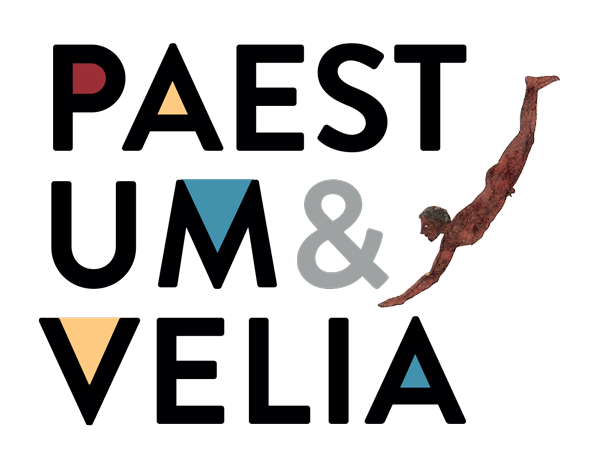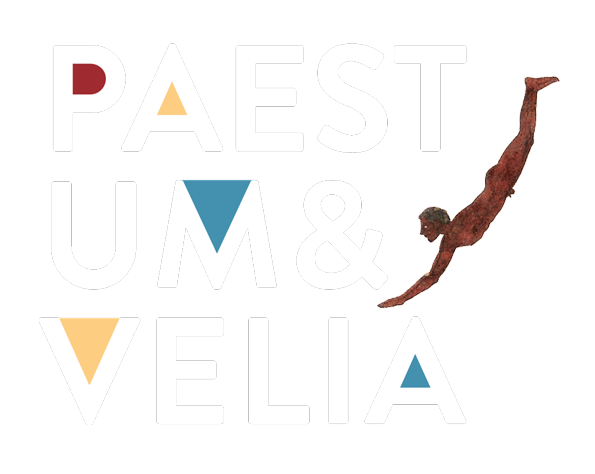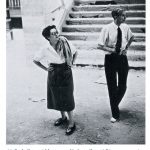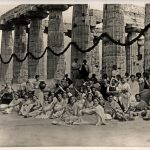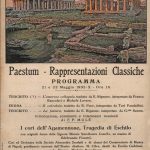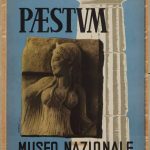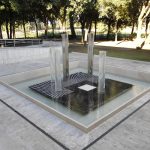- Costruzione del Museo 1952
- Foto di uno spettacolo tenutosi presso i Templi negli anni ’30
- Locandina di rappresentazioni teatrali presso i Templi
- Locandina inaugurazione Museo Archeologico Nazionale di Paestum
- Scavi anni ’50
- Fontana Carlo Alfano adiacente alla Sala Mario Napoli che ospita La Tomba del Tuffatore
It wasn’t until the early 20th century that systematic archaeological excavations were undertaken in Paestum. It was only then, indeed, that director Vittorio Spinazzola decided to end the isolation of the temples and to study the city. He thus unearthed the thoroughfares and a large part of the souther Sanctuary.
In the Fascist period the excavations, aimed at rediscovering the glorious vestiges of the Roman world, focused on the Forum and on the Temple of Peace. Nobody was really interested in the testimonies of the Greek period at the time, yet the greatest discovery of those years indeed concerned the Greek heritage: on 9 April 1934, the archaeologists Paola Zancani Montuoro and Umberto Zanotti Bianco announced the discovery of the Sanctuary of Hera at the mouth of the Sele with its spectacular metopes.
Their research had been funded by the Magna Graecia Company founded by Zanotti Bianco, and continued for several years, despite the hostility of the regime. What is more, the importance of the discovery was such, that then superintendent Amedeo Maiuri did not hesitate to commission the project of a new museum to give a worthy home to the metopes. However, the building was only erected after the war and inaugurated in 1952.
The war had obviously stopped any activity, but even during those years Paestum held a nice surprise in store. After landing at Salerno in 1943, the Allies decided to build a landing strip at Spina-Gaudo, just north of the city, and their power shovels revealed the existence of the famous necropolis of the 3rd millennium BC. Quite obviously, the landing strip was no longer built.
After the war, the superintendents Pellegrino Claudio Sestieri and Mario Napoli focused especially on the many necropolises outside the city. The spread of the phenomenon of illegal excavations, in fact, required their systematic survey, which led for the first time to the recovery of the tombs in their entirety, preserving not only the burial sets but also the painted slabs. That great era of excavations was made possible by the funding of the “Cassa per il Mezzogiorno”, the Fund for the South, aimed at countering unemployment and increasing tourism in the South thanks to archaeological discoveries. They hit the mark: among the many tombs unearthed then, there is also the most famous one, the one that still fascinates and is discussed today: the Tomb of the Diver, discovered by Mario Napoli in 1968.
In the last few decades of the century, scholars mainly focused on studying the organisation of the city and the area as a whole. The “social history” outlook led to focusing on the city’s planning evolution, its relationship with the surrounding region, the life of the inhabitants both within and outside the city, and above all, their economy. Indeed at the end of the century, in 1998, the ancient city of Paestum, jointly with Velia, the Charterhouse of Padula and the whole Cilento, entered the UNESCO List of World Heritage.
